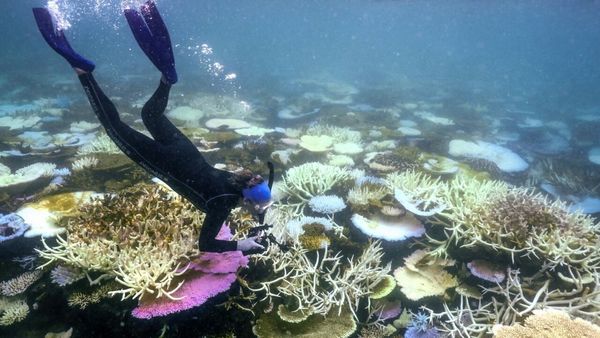
The red-finned blue-eye is no longer Australia’s rarest freshwater fish.
The last of its tiny kind – all but bullied to extinction by gambusia, an invasive fish that grows to twice the size and eight times the body mass – were a few years ago confined to a lone artesian spring in outback Queensland.
“It got very, very dire,” Bush Heritage Australia ecologist Dr Dean Gilligan says.
The species has since been reintroduced to 13 other shallow springs on Edgbaston reserve. The former cattle station, about 1,000km west of Brisbane, is home to 26 species that are found no where else in the world – including the red-finned blue-eye.
The springs, desert safe-havens of artesian water, are protected by foot-high fences made of shade cloth which keep the gambusia out and native fish populations in.
At least, that was the idea. But then a rehabilitating water table saw Edgbaston’s springs more than doubled in size over the last few years, which in turn caused about a quarter of the fences to be breached by the invasive pest.
The culprit behind the burgeoning springs is a government bore capping scheme causing the Great Artesian Basin aquifers to re-emerge. Or, in other words: it was successful environmental management.
“It’s a poison chalice,” Gilligan says. “The extra spring flow increases the size of springs that native fish and other spring fauna and flora can occupy, but it makes managing the threat much more difficult.” Three years of flooding due to above average rainfall hasn’t helped either, he adds.
With water now seeping beyond the shade cloth fence lines, opportunistic crabs and yabbies have enough real estate to burrow under them. Sensing an inflow of springs, Gilligan theorises, gambusia have followed. “It’s a prison escape, but they are trying to get into the prison, not out,” he says.
It’s put conservation efforts on the reserve in “uncharted territory”, Gilligan says. “We don’t know how much bigger those springs are going to grow.”
Once they infiltrate the fences, gambusia, also known as mosquitofish, cause havoc by nipping at the fins of native species and eating their eggs and larvae. The 4cm-long invaders were introduced to Australia from the US in 1929 in an effort to control mosquitoes and have since been declared a noxious pest. “They’re bullies” says Dr Renee Rossini, a Bush Heritage freshwater and wetlands ecologist. Without intervention, within 12 to 18 months of a breach the red-finned blue-eye will disappear.
To save the compromised populations, ecologists catch and translocate surviving native fish to heated holding tanks back at camp, poison the gambusia with a few sprinkles of off-brand vegetable derris dust (a garden pesticide), reinforce the fence line, drain the spring, wait for it to refill and finally, reintroduce the native species.
For a small spring that can take a few weeks. For larger interconnected pools of artesian water, it can take a year or longer.
However involved the process, Rossini says it’s critical to saving a species that “helps us understand how life functions, how diversity is created, how our world has changed”.
“Plants, animals and country have all come together here to create something really, really special,” she says.
It’s this value that saw Bush Heritage Australia, which bought Edgbaston in 2008, become caretakers of the fragile ecosystem to safeguard the survival of its endemic species.
It’s also the impetus behind a Queensland government decision on Saturday to recognise the land as special wildlife reserve. That affords it the same protections as a national park and will ban petroleum and mineral resource extraction on the reserve in perpetuity.
It’s the second property in the state to receive the status after legislation was introduced in 2020 to better protect private land of exceptional natural and cultural value.
Queensland environment minister, Leanne Linard, says it’s the only state in Australia to provide such a high level of protection to private property.
The agreement will “ensure this estate will remain a site of international environmental significance well into the future,” Linard says.
Bush Heritage Australia wants that same status applied to another four of its conservation blocks in Queensland.
Bidjara traditional owner, Trevor Robinson, endorsed Bush Heritage’s protection. “The land is part of Bidjara culture, our connection to country, place, storylines, language and social practices,” he says. “It’s a place that is extremely special.”
Gilligan estimates there are now more than 5,000 red-finned blue-eyes in Edgbaston, up from less than 1,000 in 2017. Despite the gains, if conservation management were to stop, their numbers would plummet within a few seasons.
“It’s a constant battle, we don’t know the answers, we are trying the best we can and hopefully we’ll stumble on a solution,” Gilligan says.
“We’ll just keep fighting the fight.”










